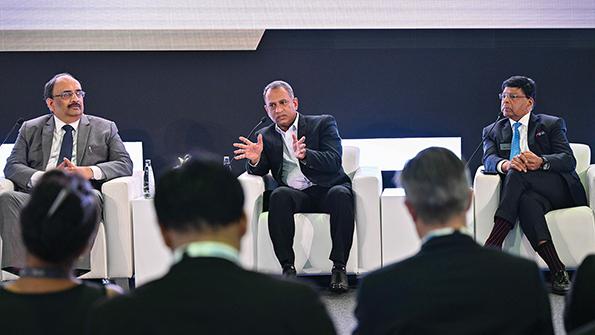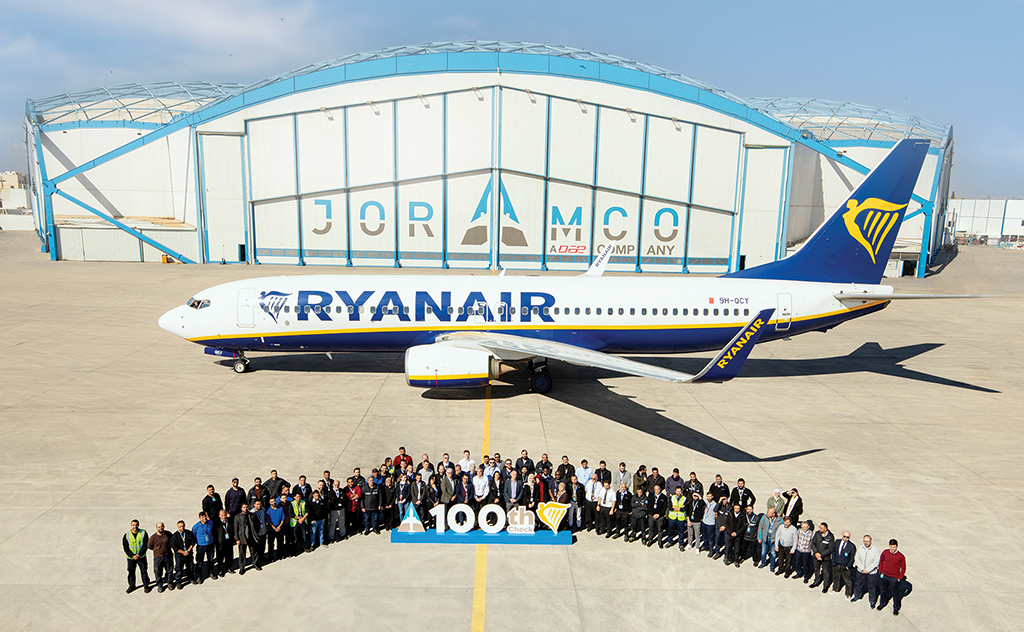This article is published in Aviation Week & Space Technology and is free to read until Jun 06, 2024. If you want to read more articles from this publication, please click the link to subscribe.

Panelists on the MRO Middle East Boom of India session (from left): Ashwani Bhargava, Boeing India senior director of supply chain; Ashok Gopinath, GMR Aero Technic president and accountable manager; and Rahul Shah, AAR Corp. senior vice president for strategic growth and business development in the Asia Pacific, Middle East and Africa.
At Aviation Week’s MRO Middle East event in February, industry leaders discussed the state of affairs for aftermarket growth in the region and how local providers are managing market challenges.
Capability and Capacity
Airlines in the Middle East reported strong revenues and profits in their latest financial results amid strong passenger demand, and aftermarket companies in the region are expanding capabilities and capacity to support them.
“Growth, growth, growth” has been the region’s theme the last few months, Lufthansa Technik Middle East (LTME) CEO Ziad Al Hazmi tells Inside MRO. One barrier is an evolving labor market, with European expatriate workers less attracted to the region.

“For the first time, I’ve noticed over the last few months that we also are having people being offered jobs there,” he says. “They are looking out to other regions.”
Supply challenges have increased over the past six months as manufacturers are stretched thin juggling high demand for new-production airframes and engines as well as supporting the aftermarket. Al Hazmi notes that parts LTME regularly needs for component repairs have longer lead times.
To counter this, he says, the MRO is investing heavily in exchanges and stock to build up inventories in the region to reduce customer wait times for whole repairs and to mitigate turnaround time lags amid parts shortages. The company is also adding capabilities to support the region’s expanding fleets amid increased services demand, having recently introduced Rolls-Royce Trent 700 nacelle MRO to its portfolio, joining General Electric GE90, CFM International CFM56 and IAE V2500 nacelle services. It is evaluating other repair services to add in the future.
Capacity in the Middle East remains somewhat constrained, given the large fleet growth in the region and strong MRO demand from airlines. The United Arab Emirates’ (UAE) Mohammed bin Rashid Aerospace Hub (MBRAH) in Dubai South expects to break ground this year on five new hangars, most of them for maintenance. It includes a facility for ATS Technic, a European Union Aviation Safety Agency-certified line maintenance company in the UAE that signed a contract with MBRAH for a two-bay narrowbody facility at MRO Middle East. The facility should be complete by mid-2025, MBRAH CEO Tahnoon Saif tells Inside MRO.
In addition, FlyDubai announced at the November Dubai Airshow it aimed to build a $190 million facility slated to open in late 2026. There are also plans for an interior completions center for UUDS Aero and one hangar each for private jet company Midline Aviation and Dubai-based asset manager Tim Aviation. Private aviation and maintenance are driving most of the hub’s growth. “They’re two distinct industries, but they are competing with each other” in growth, Saif says.
Other regional players have confirmed plans to ramp up capacity to accommodate increasing demand, including Jordan-based maintenance specialist Joramco, which is growing repair volumes for Irish low-cost airline Ryanair. Over the next decade, Joramco will support 10 lines of maintenance for Ryanair’s Boeing 737 fleet. The agreement, announced in February, expands on a previous five-year contract from 2023 for six lines of heavy maintenance.
Meanwhile, Emirates’ engineering arm plans to build a new MRO facility at Al Maktoum International Airport to expand maintenance capacity for its growing fleet. In Abu Dhabi, Etihad Engineering has added widebody capacity to its base, and Sanad has outlined plans to expand its capabilities in engine components and auxiliary power units through overseas partnerships.
Barriers
With supply chain challenges restricting access to and lead times for OEM parts and used serviceable material, operators in the Middle East are increasingly looking to alternative parts sourcing. These include parts manufacturer approval (PMA) parts and designated engineering representative repairs, a trend reflected by the wider global market.
“We’ve seen huge growth not just in the Middle East but also in the greater commercial market,” says Jim O’Sullivan, vice president for business development at Heico. He notes that the Middle East has seen strong growth since the waning of the COVID-19 pandemic and the resulting supply chain challenges.
Ahmad Rajei, senior director for design, engineering and innovation at Etihad Engineering, says that while the aftermarket’s penchant for PMA parts has grown, it has not been as aggressive as he feels it should be. Rajei cites the slow reactiveness to PMA certifications by regulators outside the U.S. and Europe as well as long-standing reluctance from lessors to accept those parts.
AFI KLM E&M Vice President for Customer Business Didier Verte agrees that some regulators are impeding more widespread PMA adoption. “It’s not just authorities in the Middle East but in different regions also,” he says.
Moreover, Verte sees PMA reluctance coming also from “commercial issues” related to OEMs that may not welcome competition from the PMA market. “A lessor, for instance, can be reluctant having PMAs in their asset because they’ve been convinced that an asset containing PMAs will lose some of its value,” he says. “All of these factors are actually slowing down the penetration of PMAs in the industry.”
An audience poll echoed this view, finding contractual arrangements, particularly with lessors, to be the main barrier to more widespread PMA adoption.
On this topic, Heico’s O’Sullivan believes there is never a “one-size-fits-all” approach and encourages operators to speak to their lessors to foster a better understanding of their requirements in relation to PMA parts. “There may be restrictions on certain components and even within those components, there may be other restrictions,” he says. “But ‘no’ doesn’t always mean ‘no’ in this instance, because generally what a lessor does not want at the end of the lease is a surprise. They want a smooth transition.”
Etihad’s Rajei says that aside from contractual arrangements, there must be a better general understanding of PMA parts. “With the lack of components in the market, there’s a lot of emphasis and a lot of work [that] has to be done by the local authority to understand and take responsibility for as well as to accept PMA parts,” he says.
Potential Tie-Ups
Saudi Arabia’s ambitions to become an established player in aviation are well known and already backed handsomely by the country’s state fund. Over the past few years, the country has founded a second flag carrier, Riyadh Air, and expanded established flag carrier Saudia along with low-cost airline Flynas. About 600 new aircraft are expected to enter the country’s commercial aircraft fleet over the next decade. Such a large fleet expansion has required Saudia Arabia to grow its domestic aviation infrastructure, including its MRO ecosystem.
Much of this maintenance activity in the near term will run through Saudia Technic, Saudia’s recently rebranded maintenance and engineering unit. It conducts line, base, components and engine maintenance at its base in Jeddah and in late 2023 unveiled plans to build an “MRO Village” there. In the long term, Saudia Technic aims to build a center for engine maintenance with a test cell to service both narrowbody and widebody engine types.

The MRO provider says construction of the new site will increase hangar capacity and the number of component shops, which it hopes will garner it a larger share of the country’s future market demand.
Another expected expansion route: joint ventures and partnerships between local Saudi partners and Western OEMs and MROs. Mature aircraft trader and lessor Vallair, for example, announced at the Dubai Airshow in November the signing of a memorandum of understanding with the Saudi government-led National Industrial Development Center (NIDC), set up to develop five key sectors in the country while driving exports overseas.
The NIDC will guide Vallair as it looks to establish a footprint in the country, with the fully operational business incorporating narrowbody MRO, aircraft disassembly, component repair shops, aircraft painting and full training functions.
While Vallair President and CEO Gregoire Lebigot says the project remains in the planning phase, he envisages the facility being set up outside the two major cities of Riyadh and Jeddah. He is scheduled to visit Saudi Arabia in April to view two possible locations.
No set timeline was disclosed for the start of the operation, but Lebigot says it will be established in phases involving Vallair and three partners: the NIDC, followed by a local airport authority cluster and a local investor set to become a shareholder in the joint venture.
The first site set up will likely be a training school, which Lebigot says should be up and running relatively quickly, given that it will be an extension of Vallair’s existing training approvals. He says the company is targeting a start date for the training venture in late 2024.
Once the joint venture commences operations, Lebigot wants the Saudi Arabian business to emulate its base in Chateauroux in central France. “Chateauroux is a huge airport where we can store aircraft, and generally doing this doesn’t fit well with busy passenger airports,” he explains.
India on the Rise
India, though situated outside the Middle East, has shaped the region for some time and is expected to continue to do so—for instance, as a long-standing source of skilled labor. Countries such as the UAE have long turned to its technicians to help fulfill workforce requirements.
Given impressive growth projections for India’s commercial fleet and aftermarket, which is estimated to grow to $53.8 billion by 2033, more overseas companies can be expected to establish themselves there in the form of joint ventures.
U.S. MRO provider AAR is among those already doing so, having set up a joint venture with Indamer in the central Indian city of Nagpur in 2021, initially focusing on narrowbody aircraft. The company plans to expand to accommodate another 8-10 narrowbody and widebody hangars.
“The growth of the fleet requires MRO to grow and then build more capacity,” says Rahul Shah, AAR’s senior vice president for strategic growth and business development for Asia Pacific, the Middle East and Africa. He predicts a combination of new aircraft and an estimated annual influx of several thousand domestic skilled technical workers supporting the pipeline. “There is going to be a tremendous opportunity for growth in India,” he adds.
Access to staff will not be an issue, given India’s population of around 1.4 billion, but the challenge could lie in fine-tuning workers’ skills, says Ashok Gopinath, president and accountable manager at India-based GMR Aero Technic. To address this, the company recently established a school of aviation in Hyderabad. Gopinath says that while the expense of running facilities are similar in most regions, India holds an advantage through its low setup costs owing to its more effective and technically oriented labor pool.
While India appears well resourced in terms or workforce, the scenario of overseas companies poaching domestic talent still lingers. The consensus is that the country needs to advance its maintenance capabilities to capture future work and prevent MRO from being outsourced abroad.
Last year, GMR Aero Technic partnered with Boeing to establish the country’s first Boeing 737 passenger-to-freighter conversion site, which is expected to begin operations by 2025.
Adding engine and component capabilities—both underserved domestically—will be a long-term goal for the country, says Ashwani Bhargava, Boeing senior director of supply chain in India. He points to new ventures such as Safran’s Leap facility in Hyderabad and Air India’s expanded MRO facilities as examples.
Bhargava expects an upturn in engine and component MRO in the future, but he says Boeing will be very selective about which partnerships and capabilities it takes on in the country.






